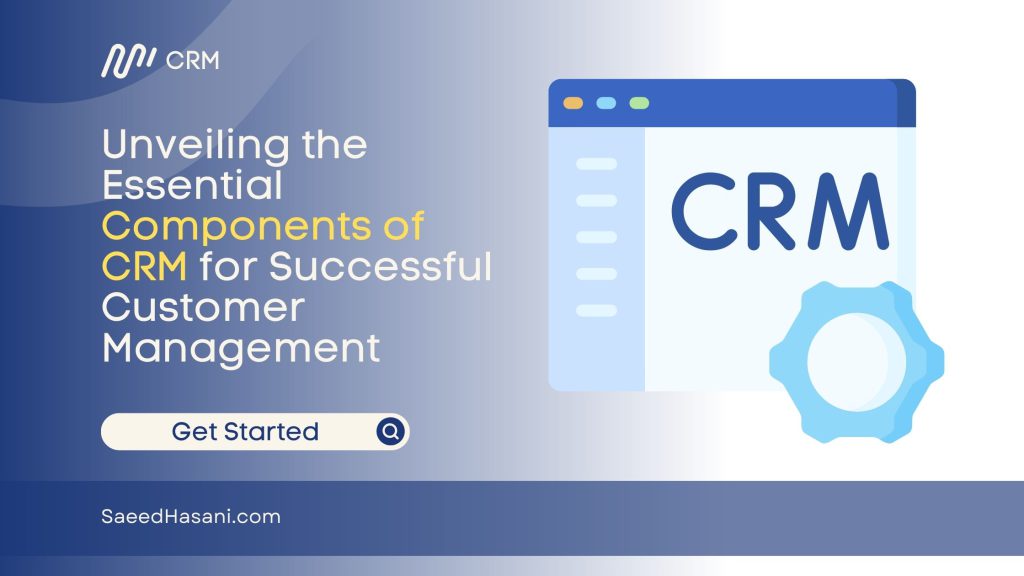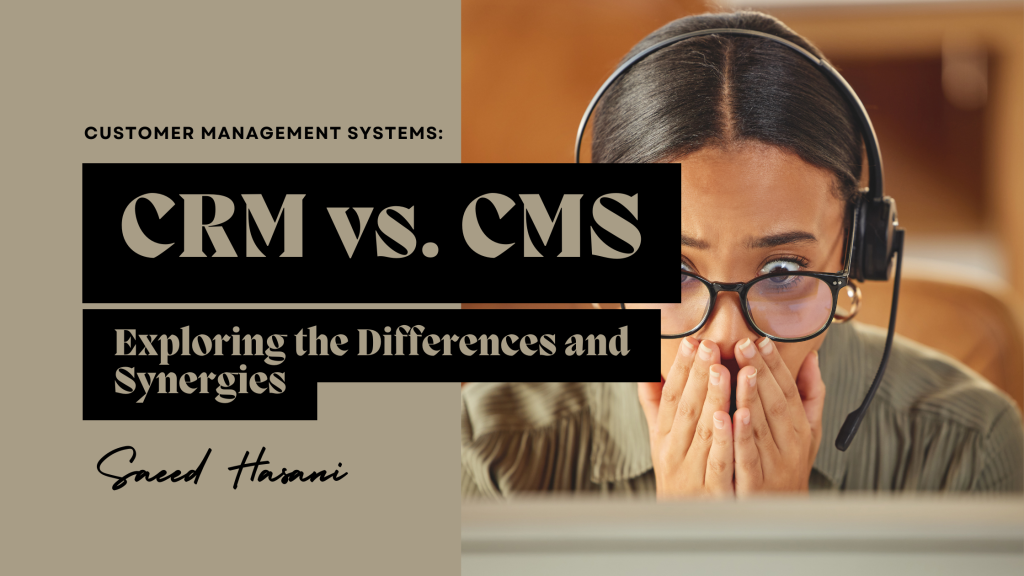Unveiling the 12 Essential Components of CRM for Successful Customer Management

Are you looking to enhance your customer relationships and drive business growth? Understanding the components of CRM is essential for achieving these goals.
From customer data management to lead nurturing and marketing automation to customer service, CRM encompasses various key components that contribute to a successful customer-centric approach.
In this article, we will explore the components of a CRM, the role of customer data, the importance of customer service, the integration of lead management, and the essential elements of a CRM strategy.
Discover how these components work together to foster customer engagement, improve customer satisfaction, and boost your organization’s success.
Content Overview:
What are the components of CRM?
The components of Customer Relationship Management (CRM) typically include the following:
- Customer Data: This component involves collecting, storing, and managing comprehensive customer information, including contact details, purchase history, preferences, interactions, and any other relevant data.
- Lead Management: Lead management focuses on capturing and nurturing potential customers or leads, tracking their interactions, and converting them into sales opportunities.
- Marketing Automation: Marketing automation allows for automating marketing activities such as campaign management, email marketing, lead generation, and segmentation to enhance customer engagement and conversion rates.
- Customer Service and Support: This component focuses on managing customer inquiries, complaints, and support requests, ensuring timely resolution and maintaining customer satisfaction.
- Contact Management: Contact management involves organizing and managing customer and prospect contact information, including details of interactions, preferences, and communication history.
- Social Media Integration: Integrating social media channels with CRM enables monitoring and engaging with customers on social platforms, capturing social insights, and leveraging social media data for better customer understanding.
- Analytics and Reporting: Analytics and reporting provide insights into customer behavior, trends, sales performance, customer satisfaction levels, and other key metrics, enabling data-driven decision-making and performance evaluation.
- Customer Engagement: Customer engagement focuses on fostering meaningful and ongoing interactions with customers through personalized communication, loyalty programs, feedback mechanisms, and targeted marketing campaigns.
- Integration with Business Systems: CRM integration with other business systems, such as ERP (Enterprise Resource Planning), marketing automation, and e-commerce platforms, facilitates data sharing and streamlines business processes.
- Workflow Automation: Workflow automation automates routine tasks, approvals, and processes within the CRM system, enhancing operational efficiency and reducing manual effort.
- Customer Self-Service: Customer self-service components enable customers to access and manage their accounts, request support, and find answers to their queries independently through online portals, FAQs, knowledge bases, or chatbots.
- Customer Analytics: Customer analytics involves using advanced analytics techniques to gain insights into customer behavior, preferences, and trends, allowing businesses to make data-driven decisions and improve customer experiences.
These are the essential ingredients of CRM, although the specific features and functionalities can differ based on the CRM software or system in use.
Why are the components of CRM essential?
The components of CRM are super important because they help keep everything about customer relationships organized and effective. Think of them as the gears in a well-oiled machine.
Each component—from managing customer data and interactions to integrating with social media and ensuring effective communication—plays a critical role.
They help businesses understand their customers better, tailor services to customer needs, streamline processes, and, ultimately, boost sales and customer satisfaction. So, having a solid CRM system is like having a secret weapon for customer engagement and growth!
What is the role of customer data in CRM components?
Customer data plays a crucial role in the components of CRM. It serves as the foundation for effective customer relationship management and enables businesses to understand, engage, and serve their customers better. Here are some key roles of customer data in CRM components:
- Customer Understanding: Customer data provides valuable insights into customers’ preferences, behaviors, demographics, purchase history, communication preferences, and more. This understanding helps businesses tailor their offerings, marketing messages, and overall customer experience to meet individual customer needs.
- Personalization: With access to customer data, businesses can personalize their interactions and offerings. By leveraging customer data, companies can deliver targeted marketing campaigns, personalized product recommendations, and customized experiences that resonate with individual customers, leading to higher engagement and customer satisfaction.
- Segmentation and Targeting: Customer data allows for segmenting customers based on various criteria such as demographics, buying behavior, or preferences. This segmentation enables businesses to create targeted marketing campaigns, design relevant offers, and allocate resources effectively to reach the right audience.
- Relationship Building: Customer data helps businesses build stronger relationships with their customers. By understanding their preferences, communication history, and purchase patterns, companies can engage customers in meaningful ways, provide personalized support, and anticipate their needs, fostering trust and loyalty.
- Sales and Lead Management: Customer data supports effective lead management and sales processes. It allows businesses to track leads, identify prospects, and understand where customers are in the sales pipeline. This information helps sales teams prioritize leads, personalize their approach, and nurture relationships for successful conversions.
- Customer Service and Support: Customer data enables efficient customer service and support. Agents can access customer data to understand their history, previous interactions, and issues, enabling them to provide prompt and personalized assistance. This leads to faster problem resolution, improved customer satisfaction, and enhanced loyalty.
- Analytics and Insights: Customer data serves as the foundation for CRM analytics and reporting. By analyzing customer data, businesses can derive valuable insights about customer behavior, trends, sales performance, and campaign effectiveness. These insights drive data-driven decision-making, optimize marketing strategies, and improve overall business performance.
- Continuous Improvement: Customer data provides feedback and insights that enable businesses to continuously improve their products, services, and customer experience. By analyzing customer data, companies can identify areas for improvement, detect patterns, and make data-backed decisions to enhance customer satisfaction and loyalty.
In summary, customer data empowers businesses to understand their customers, personalize interactions, target marketing efforts, streamline sales and support processes, gain insights, and continuously improve. It forms the backbone of CRM components, enabling businesses to build strong customer relationships and drive business growth.
How does lead management fit into the components of CRM?
Lead management is a critical component of Customer Relationship Management (CRM) and plays a vital role in the overall CRM process.
It specifically focuses on the management of potential customers or leads throughout their lifecycle, from initial contact to conversion and beyond. Here’s how lead management fits into the components of Customer Relationship Management:
- Lead Capture: Lead management starts with capturing leads, which involves collecting relevant information about potential customers, such as their contact details, interests, and demographics. This component often includes lead generation activities like website forms, landing pages, online ads, and offline marketing campaigns.
- Lead Tracking and Qualification: Once leads are captured, CRM systems enable the tracking and qualification of leads. This involves assigning scores or ratings to leads based on criteria such as their level of interest, buying intent, and fit with the company’s target customer profile. Lead tracking allows sales and marketing teams to prioritize their efforts and allocate resources effectively.
- Lead Nurturing: Lead nurturing is a crucial aspect of lead management. It involves building relationships with leads over time, typically through targeted and personalized communication. CRM systems facilitate automated lead nurturing workflows, such as sending relevant content, follow-up emails, and nurturing campaigns to keep leads engaged and move them closer to conversion.
- Sales Opportunity Management: As leads progress through the sales pipeline, they may become qualified sales opportunities. CRM systems enable the tracking and management of these opportunities, providing a comprehensive view of each opportunity’s stage, value, probability of closure, and associated activities. Sales teams can use this information to prioritize and focus on the most promising opportunities.
- Lead Conversion and Customer Onboarding: When a lead is ready to make a purchase, lead management ensures a smooth transition from lead to customer. CRM systems facilitate the conversion process, enabling seamless handoffs between sales and customer service teams. Lead data is transferred to the customer record, and relevant information is used to onboard and welcome the new customer.
- Lead Analysis and Reporting: Lead management components in CRM systems provide analytics and reporting capabilities to track the effectiveness of lead generation and conversion efforts. These tools allow businesses to analyze lead sources, conversion rates, sales velocity, and other metrics to optimize lead management strategies and identify areas for improvement.
- Lead Recycling and Retargeting: Not all leads immediately convert into customers. CRM systems enable the recycling and retargeting of leads that have shown interest but have not yet made a purchase. By segmenting and nurturing these leads further, businesses can maintain engagement and increase the chances of future conversion.
By integrating lead management into CRM system components, businesses can streamline their lead generation, qualification, nurturing, and conversion processes.
This ensures that potential customers are effectively managed and guided through the sales pipeline, increasing the efficiency of sales and marketing efforts and ultimately improving customer acquisition and retention.
What are the essential components of CRM strategy?
A comprehensive CRM strategy typically includes several essential elements that work together to achieve the organization’s customer-centric goals. Here are the key elements of a CRM strategy:
- Clear Vision and Objectives: A CRM strategy should start with a clear vision and well-defined objectives that align with the organization’s overall business goals. This includes identifying the desired outcomes, such as improving customer satisfaction, increasing customer loyalty, driving revenue growth, or enhancing operational efficiency.
- Customer Segmentation and Targeting: Effective CRM strategies involve segmenting customers based on relevant criteria such as demographics, buying behavior, preferences, or value. This segmentation helps in understanding different customer groups and tailoring marketing and service efforts to meet their specific needs and preferences.
- Customer Data Management: Successful CRM strategies rely on robust customer data management practices. This involves collecting, organizing, and maintaining accurate and up-to-date customer data, including contact information, purchase history, interactions, and preferences. Proper data management ensures a holistic view of customers and enables personalized engagement.
- Technology and Infrastructure: CRM strategies require a suitable technology infrastructure to support data integration, automation, and analysis. This may involve implementing a CRM system or leveraging existing tools and technologies to effectively manage customer data, automate processes, and enable seamless customer interactions across channels.
- Cross-Departmental Collaboration: Collaboration between departments, particularly sales, marketing, and customer service, is crucial for a successful CRM strategy. Aligning teams, sharing customer insights, and fostering cooperation ensure a consistent and unified approach to customer engagement and satisfaction.
- Customer Experience Design: CRM strategies should prioritize the design and delivery of exceptional customer experiences at every touchpoint. This involves mapping the customer journey, identifying pain points, and implementing strategies to deliver personalized, seamless, and consistent experiences across multiple channels.
- Metrics and Performance Measurement: Establishing key performance indicators (KPIs) and metrics to measure the effectiveness of CRM efforts is vital. These may include customer satisfaction scores, customer lifetime value, churn rates, customer acquisition costs, or revenue generated from existing customers. Regular measurement and analysis help in identifying areas for improvement and tracking the success of the CRM strategy.
- Training and Employee Engagement: Engaging and training employees on the CRM strategy is essential for its successful implementation. Providing employees with the necessary skills, knowledge, and tools to deliver exceptional customer experiences and encouraging their active participation in CRM initiatives enhances the effectiveness of the strategy.
- Continuous Improvement: CRM strategies should be dynamic and continuously evolving. Regular evaluation, analysis of results, and feedback from customers and employees help in identifying areas for improvement and making necessary adjustments to the strategy. Continuous learning and adaptation ensure that the CRM strategy remains effective and aligned with changing customer needs and market dynamics.
By considering these essential CRM elements, organizations can develop and implement a robust CRM strategy that aligns with their goals, enhances customer relationships, and drives business growth.
Why is customer service an important component of CRM?
Customer service is an essential component of Customer Relationship Management (CRM) because it plays a crucial role in building and maintaining strong relationships with customers. Here are some reasons why customer service is important in the CRM context:
- Customer Satisfaction: Effective customer service ensures that customers’ needs, queries, and concerns are addressed promptly and satisfactorily. It helps in resolving issues, providing assistance, and delivering a positive experience. Satisfied customers are more likely to remain loyal, make repeat purchases, and recommend the company to others.
- Retention and Loyalty: Good customer service contributes to customer retention and fosters long-term loyalty. When customers receive excellent support and personalized attention, they feel valued and are more likely to stay with the company. This leads to increased customer lifetime value and reduces churn.
- Brand Reputation: The quality of customer service directly impacts the brand’s reputation and perception. Positive experiences with customer service create a favorable impression of the company and its commitment to customer satisfaction. Conversely, poor customer service can harm the brand’s reputation and result in negative word-of-mouth.
- Competitive Advantage: In today’s competitive business landscape, providing exceptional customer service can differentiate a company from its competitors. It becomes a competitive advantage that sets the company apart and attracts customers who prioritize a superior service experience.
- Customer Insights: Customer service interactions generate valuable insights about customer preferences, pain points, and expectations. By capturing and analyzing customer feedback, businesses can identify areas for improvement, enhance their products or services, and tailor their offerings to meet customer needs more effectively.
- Upselling and Cross-selling Opportunities: Effective customer service interactions provide opportunities to identify additional needs and recommend relevant products or services. Customer service representatives who are knowledgeable and proactive can suggest upsells or cross-sells, increasing revenue generation and customer satisfaction.
- Customer Advocacy: When customers receive exceptional service, they are more likely to become advocates for the brand. They may share positive experiences on social media, provide testimonials, or refer the company to others. This word-of-mouth marketing from satisfied customers can significantly benefit the business.
Customer service is vital in CRM because it directly impacts customer satisfaction, retention, brand reputation, and competitive advantage. It provides opportunities for meaningful customer interactions, gathers valuable insights, and fosters long-term relationships that contribute to business growth and success.
How does customer engagement fit into the components of CRM?
Customer engagement is a critical component of Customer Relationship Management (CRM) as it focuses on actively involving customers in meaningful interactions and building long-term relationships. Here’s how customer engagement fits into the components of CRM process:
- Multi-channel Communication: Engaging with customers across multiple channels, such as social media, email, chat, and in-person interactions, allows businesses to meet customers where they are most comfortable. It ensures consistent and seamless communication, providing customers with convenient and personalized experiences across various touchpoints.
- Proactive Customer Support: Customer engagement involves proactive customer support, where businesses reach out to customers to address their concerns, provide assistance, and offer relevant solutions. This proactive approach demonstrates attentiveness and responsiveness, leading to higher customer satisfaction and loyalty.
- Feedback and Surveys: Engaging customers through feedback and surveys allows businesses to gather direct insights into customer experiences, satisfaction levels, and areas for improvement. It enables businesses to refine their products, services, and processes based on customer feedback, enhancing overall customer satisfaction.
- Social Media Engagement: Social media platforms provide a powerful channel for customer engagement. By actively participating in social media conversations, responding to customer inquiries, and sharing relevant content, businesses can foster a sense of community and build strong relationships with their customers.
- Customer Journey Mapping: Customer engagement plays a crucial role in understanding the customer journey and identifying touchpoints where businesses can effectively engage with customers. By mapping the customer journey, businesses can optimize interactions at each stage, ensuring a consistent and engaging experience.
Customer engagement is an integral part of CRM, as it enables businesses to actively involve customers, build relationships, and create personalized experiences. By leveraging customer engagement strategies and tools, businesses can enhance customer satisfaction, foster loyalty, and drive long-term success.
What are the components of Social CRM?
Social CRM (Customer Relationship Management) refers to the application of CRM principles and strategies to social media platforms and interactions. It encompasses the use of social media channels to engage with customers, build relationships, and gather insights. The components of Social CRM include:
- Social Listening: This component involves monitoring and analyzing social media platforms to gather information about customers, their preferences, sentiments, and discussions related to the brand or industry. Social listening tools help businesses track mentions, keywords, and conversations to understand customer needs and identify opportunities for engagement.
- Social Engagement: Social CRM emphasizes active engagement with customers on social media platforms. This component involves responding to customer inquiries, comments, and messages in a timely manner. It also includes proactive engagement through content sharing, community building, and fostering discussions to build relationships and provide value to customers.
- Social Analytics: Social CRM utilizes social media analytics to gain insights into customer behavior, trends, and campaign effectiveness. Analyzing metrics such as reach, engagement, sentiment analysis, and conversion rates helps businesses assess the impact of social media efforts and make data-driven decisions to optimize their strategies.
- Social Collaboration: Social CRM encourages collaboration and cross-functional communication within organizations to ensure a unified approach to social media engagement. It involves sharing customer insights, feedback, and social media interactions across departments such as marketing, sales, and customer service to provide a cohesive and personalized customer experience.
- Social Customer Service: With Social CRM, customer service extends to social media platforms. This component focuses on addressing customer queries, concerns, and issues raised through social media channels. It requires timely and effective responses, problem resolution, and escalation processes to maintain customer satisfaction and brand reputation.
- Social Sales: Social CRM enables sales teams to leverage social media platforms for lead generation, prospecting, and relationship-building. This component involves identifying potential customers, engaging with them through social media, and nurturing leads through the sales process. It utilizes social selling techniques to build trust and credibility and ultimately drive sales.
- Social Collaboration with Customers: Social CRM recognizes the importance of co-creating value with customers through social media collaboration. It involves involving customers in product development, gathering feedback, and encouraging user-generated content. This component fosters a sense of community, loyalty, and advocacy among customers.
- Social Integration with CRM Systems: Integrating social media data and interactions into the CRM system is a crucial component of Social CRM. This integration ensures a unified view of customers, combining social media insights with traditional customer data. It enables businesses to have a holistic understanding of customers and deliver personalized experiences across channels.
By incorporating these customer relationship management components, businesses can effectively leverage social media platforms to engage with customers, gain valuable insights, and build stronger relationships.
Social CRM enhances the overall CRM strategy by extending customer interactions beyond traditional channels and tapping into the power of social media.
In the provided diagram, you can see important parts of a basic social CRM :
Additional component: Human Resource Management
Including a Human Resource Management (HRM) component in a Customer Relationship Management (CRM) system is crucial because HRM plays a key role in optimizing the use and management of human resources within an organization.
HRM ensures that the skills and abilities of employees align with their job roles, enhancing overall productivity and performance. It is especially important in CRM, as it supports effective people strategies and helps manage workforce skills to drive business growth and development.
This makes HRM an indispensable component of CRM, contributing to better management and utilization of personnel in fostering customer relationships and organizational efficiency.
How to Manage Components of CRM?
Managing CRM components can be pretty straightforward if you keep a few key steps in mind:
- Integration is King: Make sure all your CRM components talk to each other seamlessly. This avoids data silos and ensures a smoother workflow.
- Keep it User-Friendly: Design your CRM with the user in mind. If it’s easy to use, adoption across your team will be higher.
- Train and Retrain: Regular training sessions keep everyone up to speed and help leverage all the CRM features effectively.
- Stay Updated: Keep your CRM software updated to take advantage of the latest features and security updates.
- Monitor and Adjust: Regularly review how your CRM is performing. Use feedback to tweak and improve the system.
Like a great recipe, the right mix and ongoing tweaks can make managing your CRM components a piece of cake!
Conclusion
In conclusion, Customer Relationship Management (CRM) is a powerful tool that can significantly impact your business’s success.
By understanding and implementing the key elements of CRM, such as customer data management, lead nurturing, marketing automation, and exceptional customer service, you can forge strong customer relationships, enhance customer satisfaction, and drive business growth.
A well-rounded CRM strategy that integrates these components will enable you to effectively engage with your customers, deliver personalized experiences, and meet their evolving needs.
Embrace the power of CRM, and unlock the potential to build lasting customer relationships that propel your organization toward long-term success.
Sources:







Responses